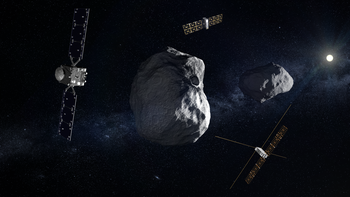
In order to apply for any of the following theses or internships, the candidate must have no more than 3 exams left.

Overview:
GUBAS (General Use Binary Asteroid Simulator) is an open-source simulation tool designed to model the full two-body dynamics of binary asteroid systems. By numerically integrating the coupled translational and rotational motion of both bodies, GUBAS enables realistic simulations of complex dynamical environments such as the Didymos–Dimorphos system, target of ESA’s Hera mission.
This capability is particularly relevant for the radio science experiment, which relies on precise modeling of the binary system’s gravity field and rotational state to extract physical parameters such as the mass, density distribution, and mutual orbit evolution of the two bodies.
Objective:
The goal of this thesis is to use GUBAS to simulate the coupled motion of Didymos and Dimorphos under different dynamical assumptions, and to assess the implications for the Hera Radio Science Experiment. The candidate will reproduce the system’s full-two-body dynamics, compare them with simplified point-mass models, and investigate how non-spherical gravity and mutual coupling affect the tracking observables used in radio science analyses.
Tasks:
Familiarize with the GUBAS framework and its implementation of full two-body dynamics.
Set up a numerical model of the Didymos–Dimorphos system using published shape, mass, and orbit parameters.
Perform simulations to study the mutual orbital and rotational evolution under realistic initial conditions.
Compare full-two-body results with classical Keplerian or restricted two-body approximations.
Analyze how dynamical effects influence the observables of the Hera Radio Science Experiment (e.g., range and Doppler signatures).
Prepare documentation and visualizations to support integration with the broader Hera radio science modeling framework.
Requirements:
Basic knowledge of orbital and rotational dynamics.
Familiarity with Python or MATLAB for data analysis and visualization.
Interest in planetary science, small-body dynamics, and radio science.
This thesis offers a unique opportunity to contribute to the Hera mission’s radio science experiment and to the modeling of binary asteroid dynamics using a state-of-the-art open-source tool developed for planetary defense and small-body research.
Topic: Planetary Defence
Tutor: Edoardo Gramigna
Uploaded: 16/12/2025

The main goal of this thesis is to evaluate the discrepancies of different methods to represent gravity, with particular focus on small bodies (asteroids and comets). The work fits into the context of two ESA missions: Hera and RAMSES. The first aims to study the binary asteroid system Didymos, subject to the first kinetic impactor experiment (DART mission). The second, instead, will be launched in 2029 and will escort the asteroid Apophis during its very close flyby with Earth. For these kind of missions, gravity representations are essential to navigate spacecrafts in proximity of small bodies since, in most of the cases, their shape is highly irregular leading to equally irregular gravity fields. Moreover, deep knowledge on a small body's gravity allows the characterization of its interior structure, unveiling features invisible from the outside.
As a first step, the candidate will have to gain confidence with gravity representations: starting from the simple point mass to more complex methods, such as spherical harmonics and polyhedron representations. The following step will be to outline how different representations affect the gravitational accelerations around the small body. Particular attention will be spent on the space within the Brillouin Sphere, i.e. the smallest sphere enclosing the whole body, where spherical harmonics are known to diverge leading to unreliable results. To do this, the candidate will have to build computational tools to aid its analysis, while some of them will be provided by the supervisor.
A possible extension of the work is to analyse the effects and observability of non-homogeneous structures of asteroids. With the tools developed in the first part, the candidate will be able to simulate more complex gravitational fields of bodies characterized by heterogeneities: for example, an asteroid with a particularly dense core. As a consequence, the effects that such heterogeneities have on gravity can be evaluated, which automatically translates as the effect on the motion of the spacecraft around the small body.
Topic: Gravity representation methods
Tutor: Federico Scalera
Uploaded: 16/12/2025

In the context of spacecraft navigation, optical navigation is one of the most promising and novel methods for enabling a spacecraft to autonomously determine its position and orientation. To obtain accurate measurements, the cameras used must be carefully calibrated and need to reliably detect light from stars.
Optical navigation provides an alternative to classical radiometric navigation — especially when the spacecraft is deep in space or out of line-of-sight from ground stations on Earth. The potential of this technique has been demonstrated in many missions (e.g., from the Voyager fly-by at Uranus) and it will be used in the upcoming HERA mission for the approach to the Didymos system.
The aim of this project is to implement a technique from the literature called Modified Moment, typically used for detecting light sources (such as stars or unresolved small bodies) in the field of view of a star camera or navigation camera. The student will work with a Python code base, and will acquire the capability to process images and detect candidate stars in HERA-like images.
Tutor: Davide Banzi
Topic: Astrometry, Data Analysis, Image Detection
Uploaded: 23/12/2025